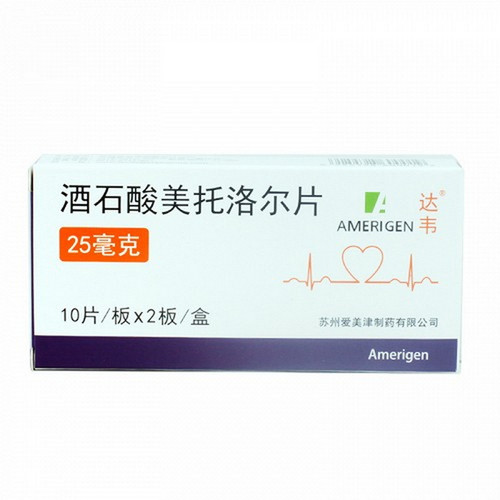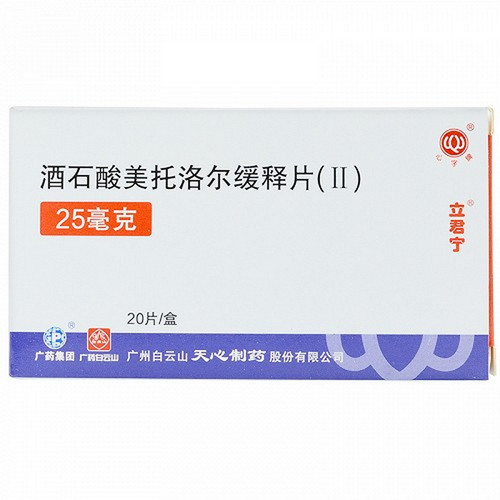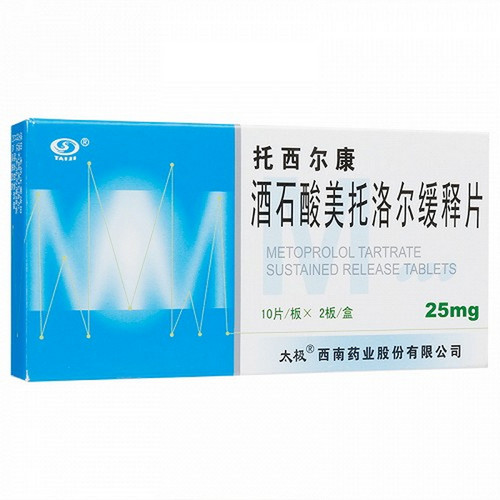Product Overview
[Generic Name] Metoprolol Tartrate Tablets
[Drug Name] Wei Te Metoprolol Tartrate Tablets
[Main Ingredients] The main ingredient of this product is metoprolol tartrate.
[Indications] Used to treat hypertension, angina pectoris, myocardial infarction, hypertrophic cardiomyopathy, aortic dissection, arrhythmias, hyperthyroidism, cardiac neurosis, etc. In recent years, it has also been used to treat heart failure; in this case, it should be used under the guidance of an experienced physician.
[Dosage and Administration] For the treatment of hypertension, 100-200 mg twice daily should be used immediately after hemodynamic stabilization. Early use within the first few hours is recommended for acute myocardial infarction, as immediate use can reduce infarct size and short-term (15-day) mortality in patients who have not undergone thrombolysis (this effect is apparent 24 hours after administration). In patients who have undergone thrombolysis, it can reduce the rate of reinfarction and re-ischemia, and can even reduce mortality if administered within 2 hours. General Usage: Initially administer metoprolol intravenously at a dose of 2.5-5 mg/dose (within 2 minutes), every 5 minutes for three doses of 10-15 mg. Then, begin taking 25-50 mg orally 15 minutes later, every 6-12 hours for 24-48 hours, followed by 50-100 mg orally twice daily.
Adverse Reactions:
The incidence of adverse reactions is approximately 10% and is generally dose-related. Common (>1/100) General side effects: fatigue, headache, dizziness Circulatory system: cold extremities, bradycardia, palpitations Gastrointestinal system: abdominal pain, nausea, vomiting, diarrhea and constipation Uncommon General side effects: chest pain, weight gain Circulatory system: temporary worsening of heart failure Nervous system: sleep disturbance, paresthesia Respiratory system: shortness of breath, bronchial asthma or bronchospasm in patients with asthma symptoms Rare (General side effects: sweating, hair loss, taste changes, reversible sexual dysfunction Hematological system: thrombocytopenia Circulatory system: prolonged atrioventricular conduction time, arrhythmia, edema, syncope Nervous system: nightmares, depression, memory impairment, confusion, nervousness, anxiety, hallucinations Skin: skin allergic reaction, exacerbation of psoriasis, photosensitivity Liver: increased transaminases Eyes: visual impairment, dry eyes and/or eye irritation Ears: tinnitus Rare cases of arthralgia, hepatitis, painful muscle cramps, dry mouth, conjunctivitis-like symptoms, rhinitis, impaired concentration, and gangrene have been reported in patients with concomitant vascular disease.
[Precautions]
Renal Impairment: Renal function has no significant effect on the clearance of this drug; therefore, no dose adjustment is required in patients with renal impairment. Hepatic Impairment: The dose of metoprolol for patients with cirrhosis is generally the same as that for patients with normal hepatic function. Dose reduction should only be considered in patients with very severe hepatic impairment (e.g., patients undergoing bypass surgery). Verapamil should not be administered intravenously to patients receiving beta-blockers. Metoprolol may exacerbate symptoms of peripheral vascular disorders, such as intermittent claudication. Caution is advised in patients with severe renal impairment, in severe emergencies with metabolic acidosis, and when used concomitantly with digitalis. This drug should not be used in patients with underlying or symptomatic cardiac insufficiency without concomitant treatment. Patients with Prinzmetal's angina may experience increased frequency and severity of angina attacks after taking beta-blockers due to alpha-receptor-mediated coronary vasoconstriction. Therefore, non-selective beta-blockers should not be used in such patients. Selective beta-1 blockers should also be used with caution. Patients with bronchial asthma or other chronic obstructive pulmonary disease should also receive adequate bronchodilator therapy, and the dose of beta-2 agonists may need to be increased. Metoprolol therapy has a lower impact on glucose metabolism or the risk of masking hypoglycemia than non-selective beta-blockers. In rare cases, pre-existing moderate atrioventricular conduction abnormalities may worsen (potentially leading to atrioventricular block). Beta-blocker therapy may interfere with the treatment of allergic reactions, and conventional doses of epinephrine do not always produce the desired effect. Patients with pheochromocytoma should consider concomitant use of an alpha-blocker when taking this drug. This medication should be withdrawn gradually, over at least two weeks, with the dose gradually reduced to 25 mg (half a 50 mg tablet). During this period, patients with known ischemic heart disease should be closely monitored, especially those with known ischemic heart disease. The risk of coronary events, including sudden cardiac death, may be increased during beta-blocker withdrawal. Anesthesiologists should be informed before surgery that patients are taking this medication. Discontinuation of beta-blockers is not recommended for patients undergoing surgery. Effects on Driving and Operating Machinery: Dizziness and fatigue may occur during treatment with this medication. Therefore, caution should be exercised when using this medication in activities requiring concentration, such as driving or operating machinery. Use with caution in athletes.
[Interactions] Metoprolol is a substrate of CYP2D6. Drugs that inhibit CYP2D6 can affect the plasma concentration of metoprolol. Drugs that inhibit CYP2D6 include quinidine, terbinafine, paroxetine, fluoxetine, sertraline, celecoxib, propafenone, and diphenhydramine. For patients taking this drug, the dose of this drug should be reduced when starting treatment with the above drugs. This drug should be avoided in combination with the following drugs: Barbiturates: Barbiturates (studies have been conducted on pentobarbital) can increase the metabolism of metoprolol through enzyme induction. Propafenone: In 4 patients who were already using metoprolol, the plasma concentration of metoprolol increased by 2 to 5 times after the administration of propafenone, and 2 of them experienced side effects related to metoprolol. This is related The interaction was confirmed in 8 healthy volunteers. A possible explanation for this interaction is that propafenone, similar to quinidine, inhibits the metabolism of metoprolol through the cytochrome P4502D6 pathway. Since propafenone also has a beta-blocking effect, its combined use with metoprolol is difficult to master. Verapamil: When verapamil is used in combination with beta-blockers (reports have been made with atenolol, propranolol and pindolol), it may cause bradycardia and a decrease in blood pressure. Verapamil and beta-blockers have additive inhibitory effects on atrioventricular conduction and sinus node function. The dose of this product may need to be adjusted when used in combination with the following drugs: Amiodarone: A case report showed that the simultaneous use of amiodarone and metoprolol may result in significant Sinus bradycardia. Amiodarone has a long half-life (about 50 days), which means that the use of metoprolol may still cause drug interactions for a long time after amiodarone treatment is stopped. Class I antiarrhythmic drugs: Class I antiarrhythmic drugs and beta-blockers have additive negative inotropic effects, so in patients with impaired left ventricular function, they may cause serious hemodynamic side effects. Patients with sick sinus syndrome and pathological atrioventricular block should also avoid the simultaneous use of metoprolol and class I antiarrhythmic drugs. There are clear data on the interaction between disopyramide and metoprolol. Nonsteroidal anti-inflammatory/antirheumatic drugs (NSAIDs): NSAID anti-inflammatory analgesics have been found to counteract the anti-hypertensive effects of beta-blockers. Blood pressure effects. In this regard, the main drugs studied are indomethacin. Beta-blockers are unlikely to interact with sulindac. In a study of diclofenac, no interaction between beta-blockers and diclofenac was found. Diphenhydramine: In people with rapid hydroxylation, diphenhydramine reduced the clearance of metoprolol metabolized to α-hydroxymetoprolol by CYP2D6 by 2.5 times. The effect of metoprolol is thus enhanced. Diphenhydramine may inhibit the metabolism of other CYP2D6 substrates. Diltiazem: Calcium antagonists and beta-blockers have additive inhibitory effects on atrioventricular conduction and sinus node function. Cases of significant bradycardia have been reported when beta-blockers are used in combination with diltiazem. Epinephrine: Approximately 1 There have been 0 case reports of patients receiving non-selective beta-blockers (including pindolol and propranolol) developing significant hypertension and bradycardia after administration of epinephrine. These clinical observations have been confirmed in studies of healthy volunteers. Epinephrine in local anesthetics may cause this reaction when administered intravascularly. It is speculated that the risk of this reaction is lower when using cardioselective beta-blockers. Phenylpropanolamine: A single dose of 50 mg of phenylpropanolamine can increase diastolic blood pressure to pathological levels in healthy volunteers. levels. Propranolol usually antagonizes this increase in blood pressure caused by phenylpropanolamine. However, in patients receiving high-dose phenylpropanolamine, beta-blockers can paradoxically cause a hypertensive reaction. Hypertensive reactions have also been reported during treatment with phenylpropanolamine alone. Quinidine: Quinidine inhibits the metabolism of metoprolol in so-called "rapid hydroxylators" (more than 90% of this type in Sweden), resulting in a significant increase in the latter's plasma concentration and enhanced beta-blocking effect. Other drugs that are hydroxylated via the same enzymatic pathway (cytochrome P450 β-blockers metabolized by 2D6) may also interact with quinidine in the same way. Clonidine: β-blockers may exacerbate the rebound hypertension that occurs when clonidine is abruptly discontinued. If co-therapy with clonidine is to be discontinued, the β-blocker should be discontinued several days before clonidine discontinuation. Rifampicin: Rifampicin can induce the metabolism of metoprolol, resulting in decreased plasma concentrations. Patients receiving other β-blockers (e.g., eye drops) or monoamine oxidase (MAO) inhibitors should be closely monitored. Inhalational anesthetics can increase the cardiodepressant effect in patients receiving β-blockers. Patients receiving β-blockers should have their oral hypoglycemic medication dose readjusted. Metoprolol plasma concentrations may increase if taken with cimetidine or hydralazine.
[Specifications]
60 tablets/box
[Approval Number]
National Medicine Standard H20123193
[Manufacturer]
Weite (Hunan) Pharmaceutical Co., Ltd.







